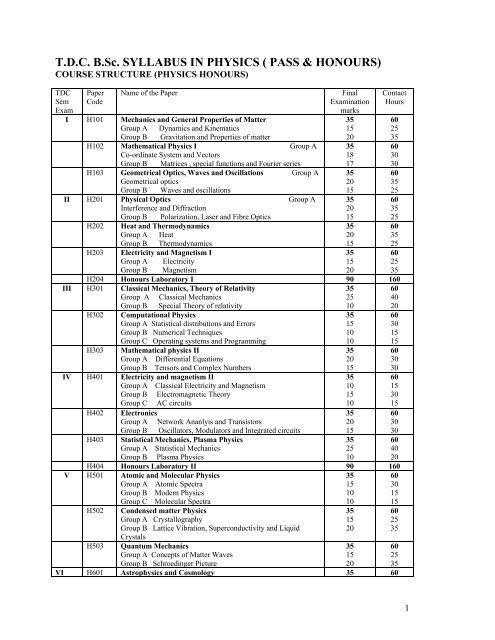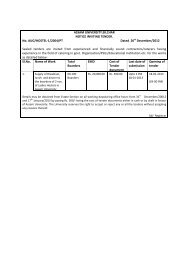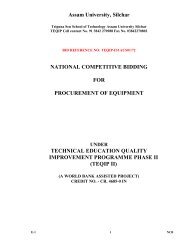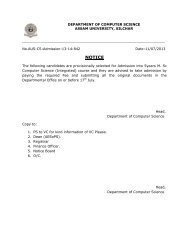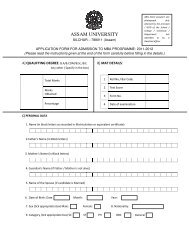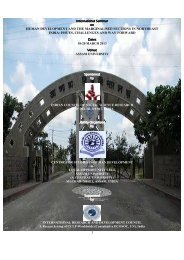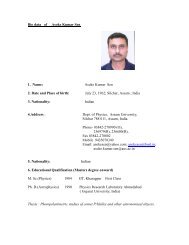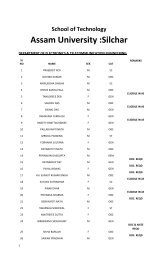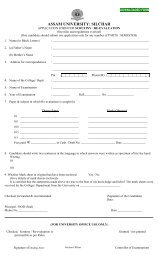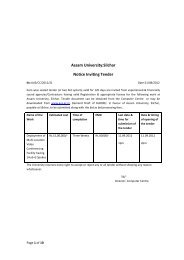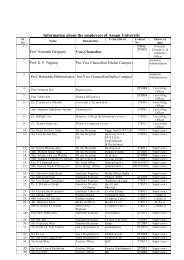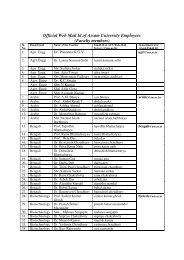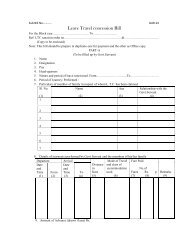T.d.c. b.sc. syllabus in physics
T.d.c. b.sc. syllabus in physics
T.d.c. b.sc. syllabus in physics
You also want an ePaper? Increase the reach of your titles
YUMPU automatically turns print PDFs into web optimized ePapers that Google loves.
T.D.C. B.Sc. SYLLABUS IN PHYSICS ( PASS & HONOURS)COURSE STRUCTURE (PHYSICS HONOURS)TDCSemExamPaperCodeName of the PaperF<strong>in</strong>alExam<strong>in</strong>ationmarks3515ContactHoursI H101 Mechanics and General Properties of Matter60Group A Dynamics and K<strong>in</strong>ematics25Group B Gravitation and Properties of matter20 35H102 Mathematical Physics I Group A 35 60Co-ord<strong>in</strong>ate System and Vectors18 30Group B Matrices , special functions and Fourier series17 30H103 Geometrical Optics, Waves and O<strong>sc</strong>illations Group A 35 60Geometrical optics20 35Group B Waves and o<strong>sc</strong>illations15 25II H201 Physical Optics Group A 35 60Interference and Diffraction20 35Group B Polarization, Laser and Fibre Optics15 25H202 Heat and Thermodynamics35 60Group A Heat20 35Group B Thermodynamics15 25H203 Electricity and Magnetism I35 60Group A Electricity15 25Group B Magnetism20 35H204 Honours Laboratory I 90 160III H301 Classical Mechanics, Theory of Relativity35 60Group A Classical Mechanics25 40Group B Special Theory of relativity10 20H302 Computational Physics35 60Group A Statistical distributions and Errors15 30Group B Numerical Techniques10 15Group C Operat<strong>in</strong>g systems and Programm<strong>in</strong>g10 15H303Mathematical <strong>physics</strong> IIGroup A Differential EquationsGroup B Tensors and Complex NumbersIV H401 Electricity and magnetism II35 60Group A Classical Electricity and Magnetism10 15Group B Electromagnetic Theory15 30Group C AC circuits10 15H402 Electronics35 60Group A Network Ananlyis and Transistors20 30Group B O<strong>sc</strong>illators, Modulators and Integrated circuits15 30H403 Statistical Mechanics, Plasma PhysicsGroup A Statistical Mechanics35256040Group B Plasma Physics10 20H404 Honours Laboratory II 90 160V H501 Atomic and Molecular PhysicsGroup A Atomic SpectraGroup B Modern PhysicsGroup C Molecular Spectra3515101060301515H502Condensed matter PhysicsGroup A CrystallographyGroup B Lattice Vibration, Superconductivity and LiquidCrystalsH503 Quantum MechanicsGroup A Concepts of Matter WavesGroup B Schroed<strong>in</strong>ger Picture351520602535VI H601 Astro<strong>physics</strong> and Cosmology 35 603520153515206030306025351
H602Group A Astro<strong>physics</strong>Group B CosmologyNuclear and Particle PhysicsGroup A Nuclear Properties and RadioactivityGroup B. Nuclear Reactions and DetectorsGroup C Particle Physics251035101015402060202020H603 Digital Electronics, Solidstate devices, Introduction toNano<strong>physics</strong>Group A Digital electronicsGroup B Solid State DevicesGroup C Introduction to Nano<strong>physics</strong>3515101060301515H604 Honours Laboratory III 90 160Total Marks 900Course Structure (PHYSICS PASS)TDCSemExamIPaperCodeP101Name of the PaperMathematical Physics, Mechanics & GeneralProperties of matter, RelativityGroup A Mathematical PhysicsGroup B Mechanics and General Properties of Matter andRelativityF<strong>in</strong>alExam<strong>in</strong>ationmarks351025ContactHoursII P201 Electricity & MagnetismGroup A ElectrostaticsGroup B MagnetismGroup C Electromagnetism3510101580252530P202 General Laboratory I 30 80III P301 Heat & ThermodynamicsGroup A HeatGroup B ThermodynamicsIV P401 Waves , O<strong>sc</strong>illations and OpticsGroup A Waves and O<strong>sc</strong>illationsGroup B Ray and Physical Optics351025802060P402 General Laboratory II 30 80V P501 Quantum Mechanics, Atomic and Nuclear PhysicsGroup A Quantum MechanicsGroup B Atomic PhysicsGroup C Nuclear PhysicsVI P601 Crystallography & ElectronicsGroup A Elements of CrystallographyGroup B ElectronicsP602 General Laboratory III 30 80Total Marks 30035152035101510351025802060804040802530258025552
DETAILED COURSES FOR PHYSICS HONOURSSemester IPAPER H101MECHANICS & GENERAL PROPERTIES OF MATTERTotal Marks- 35Pass marks -- 12Group A Dynamics and K<strong>in</strong>ematics Marks: 15Contact hours: 25Dynamics: Inertial and non <strong>in</strong>ertial frame of reference. Transformation equation of coord<strong>in</strong>ate,velocity, acceleration <strong>in</strong> rotat<strong>in</strong>g frame of reference. Radial and transverse velocities of arotat<strong>in</strong>g body. Radial and transverse accelerations. Transformation equation of force <strong>in</strong> non<strong>in</strong>ertialframes ( both rotational and l<strong>in</strong>ear). Fictitious forces -- centrifugal force and Coriolisforce. Effect of fictitious force on the earth, Focault’s pendulum . Conservative force and itsproperties. Concept of potential function. Relationship of conservative force, Motion of a body<strong>in</strong> fractional medium under gravity.Centre of mass, centre of mass frame, centre of mov<strong>in</strong>g systems, Collision: elastic and <strong>in</strong>elasticcollision, coefficient of restitution. Expression of velocities of two bodies after elastic and<strong>in</strong>elastic collision <strong>in</strong> laboratory frame. Elastic collision <strong>in</strong> centre of mass frame. Relationshipbetween angle of <strong>sc</strong>atter<strong>in</strong>gs <strong>in</strong> laboratory frame and centre of mass frame.Motion of a rigid body about a fixed axis. Angular momentum and expression of angularmomentum of a system of rotat<strong>in</strong>g bodies. Relationship of angular momentum of a system ofbodies with angular momentum <strong>in</strong> centre of mass frame. Pr<strong>in</strong>ciple of conservation of angularmomentum. Moment of <strong>in</strong>ertia. Theorems of moment of <strong>in</strong>ertia, calculation of moment of <strong>in</strong>ertia<strong>in</strong> simple cases : Spherical shell, solid sphere, cyl<strong>in</strong>der, uniform rectangular lam<strong>in</strong>a.Group B Gravitation and Properties of matterMarks:20Contact hours : 35Gravitation : Gravitational potential and <strong>in</strong>tensity, calculation of gravitational potential and<strong>in</strong>tensity due to th<strong>in</strong> spherical shell, thick spherical shell, sphere, circular di<strong>sc</strong> etc. Compoundpendulum, measurement of ‘g’ by bar and Kater’s pendulum.Elasticity : Relation between elastic constants, energy of elastically deformed bodies, torsion ofa rod, Torsional pendulum, bend<strong>in</strong>g of beam, Cantilever (loaded at one end).Surface tension : Excess pressure on curved liquid surface ( spherical bubble and drop). Theoryand experimental determ<strong>in</strong>ation of surface tension of liquid by ripple method.3
Vi<strong>sc</strong>osity of fluids: Poiseulle’s equation, determ<strong>in</strong>ation of vi<strong>sc</strong>osity of a liquid by Poiseulle’smethod.SUGGESTED READINGMechanics & General Properties of MatterMathur D.S.: Elements of Properties of MatterPurcell E.M. (Ed): Vol. I Mechanics, Mc Graw Hill. Berkely Physics Course,Feynmam R.P. et. al.: The Feynmam Lectures <strong>in</strong> Physics, Vol.I,B.I. Publication.Sengupta A & Chatterjee H.K : Treatise on General properties of matterSaraf B. et.al.: Physics Through Experiments, Vol I, Mechanical System.Vikas Publish<strong>in</strong>g House,Newman & Searle: General Properties of Matter.***PAPER H102MATHEMATICAL PHYSICS I.Total Marks-35Pass marks : 12Group A Co-ord<strong>in</strong>ate System and Vectors Marks : 18Contact Hours : 30The Co-ord<strong>in</strong>ate system : Orthogonal and non-orthogonal, Right handed and Left HandedCartesian system, Necessity for curvil<strong>in</strong>ear co-ord<strong>in</strong>ate system. Polar, cyl<strong>in</strong>drical and generalcurvil<strong>in</strong>ear coord<strong>in</strong>ate system. Length, area and volume elements <strong>in</strong> all these systems.Vectors : Vector triple product, polar and axial vectors and their examples from Physics.Vectorial equation of straight l<strong>in</strong>e, plane and circle. Base vector, vector transformations. Scalarand vector fields with illustrations from Physics, directional derivative of a <strong>sc</strong>alar field, gradientof a <strong>sc</strong>alar field, divergence and curl of vector fields and their physical mean<strong>in</strong>g, Expression forgradient, divergence and curl <strong>in</strong> curvil<strong>in</strong>ear co-ord<strong>in</strong>ates. Integration, important identities.Gauss, Green and Stoke’s theorems and their applications.4
Group B Matrices , special functions and Fourier series Marks: 17Contact hours : 30Matrices : Addition law of matrices, matrix multiplication, properties of matrices, specialsquare matrices, <strong>in</strong>verse of matrices, Elementary transformation of matrices – similarity,orthogonal and unitary transformation. Eigen value, Eigen vector. Solution of simultaneousl<strong>in</strong>ear equations. Diagonalisation of matrix.Special functions: Beta and Gamma functions, relation between them, recurrence relation forgamma function.Fourier Series: Fourier’s Theorem and Fourier series, application of Fourier’s theorem tosquare wave and saw tooth waveSUGGESTED READINGMathematical PhysicsHaperSchaum SeriesH<strong>in</strong>chey F.A.Joshi A.W.Margendu and Murphy,Rai S<strong>in</strong>ghania M D: Introduction to Mathematical Physics: Vectors: Vectors and Tensors, Wiley Eastern: Matrices and Tensors <strong>in</strong> Physics 2 nd Ed, Wiley Eastern: Mathematics for Eng<strong>in</strong>eers and Physicists.: Vector Analysis, S.Chand***PAPER H 103GEOMETRICAL OPTICS, WAVES & OSCILLATIONSTotal marks : 35Pass Marks :12Group A: Geometrical OpticsMarks-20Contact Hours : 35Fermat’s pr<strong>in</strong>ciples. Deduction of laws of reflection and refraction us<strong>in</strong>g Fermat’s pr<strong>in</strong>ciple forplane and curved surfaces. Deduction of lens maker’s formula. Thick lens : card<strong>in</strong>al po<strong>in</strong>ts(deduction not necessary). Focal length of two th<strong>in</strong> lenses separated by a distance.5
Defects of image: monochromatic aberration and chromatic aberration, Different types ofmonochromatic aberration and their explanation. Chromatic aberration and its correction,Achromatic comb<strong>in</strong>ation of lens & prism.Spherical aberration and its removal by different methods. Condition of least sphericalaberration when two lenses are employed. Aplanatic surface and aplanatic po<strong>in</strong>ts. Explanation oftransparent sphere as aplanatic surface, Extension of the above idea <strong>in</strong> construction of Abbe’shigh power oil immersion objective of micro<strong>sc</strong>ope.Different types of magnifications : Transverse, longitud<strong>in</strong>al, angular and their relationship.Deduction of Helmholtz-Lagrange’s equation and Abbe’s s<strong>in</strong>e condition.Eyepiece : Ramsden and Huygen eyepiece-construction, pr<strong>in</strong>ciples and relative advantage anddisadvantage.Group B : Waves and O<strong>sc</strong>illationsMarks-15Contact hours : 25Simple harmonic motion: Simple harmonic o<strong>sc</strong>illation - differential equation and its solutionInstantaneous and average total energy. Superposition of two simple harmonic motions,Lissajous figures. Damped and forced vibrations. Energy of damped and forced vibrations,Instantaneous and average power of forced vibration, Sharpness of resonance,Wave: L<strong>in</strong>ear equation of plane progressive wave motion <strong>in</strong> one and three dimension,Instantaneous and average energy of one dimensional wave, Propagation <strong>in</strong> dispersive medium –Group and phase velocityVibration of str<strong>in</strong>gs: Wave equation <strong>in</strong> l<strong>in</strong>ear approximation, Eigen values and eigen functionsof pluck and stuck str<strong>in</strong>g, Energy of transverse vibration..SUGGESTED READINGOpticsJenk<strong>in</strong>s and White,: Fundamentals of Optics McGraw HillGhatak A.K.: Physical OpticsBorn and Wolf: OpticsKhandelwal D.P.,: Optics and Atomic Physics, Himalaya Publish<strong>in</strong>gHouseLaud B.B.: Lasers and Non-l<strong>in</strong>ear optics, Wiley EasternLonghurs R.S. : Geometrical and Physical optics. Longmans, 19756
K G Majumder and B Ghosh: A Text Book of Light, Shreedhar PublicationsWaves and AcousticsGhosh R.K. : The Mathematics of waves and Vibrations, Mc Millan , 1975Khandelwal D.P. : O<strong>sc</strong>illation and waves, Himalaya Publish<strong>in</strong>gPuri S.K. : Vibration and Waves, Tata Mc Graw HillWood A.B. : A Text Book of SoundBhattacharjee K. : A Text Book of SoundBerkely Ma<strong>in</strong> I.G. : Vibrations and Waves, CambridgePa<strong>in</strong> H.J. : The Physics of Vibration and waves, Mc Millan, 1975/Willcy Elbs***Semester IIPAPER H 201PHYSICAL OPTICSMarks-35Contact Hours : 60Group A Interference and DiffractionMarks:20Contact hours : 35Interference of Light : Condition of susta<strong>in</strong>ed <strong>in</strong>terference by analytical treatment, Divisionamplitude and division of wave front, methods for production of <strong>in</strong>terference fr<strong>in</strong>ges by biprism,Lloyd’smirror- determ<strong>in</strong>ation of wavelength, measurement of thickness of th<strong>in</strong> films,colour of a th<strong>in</strong> film <strong>in</strong> reflected and transmitted light, Haid<strong>in</strong>ger’s fr<strong>in</strong>ge, Theory of Newton’sr<strong>in</strong>gs. Determ<strong>in</strong>ation of wavelength and refractive <strong>in</strong>dex us<strong>in</strong>g Newton R<strong>in</strong>g apparatus .Interferrometer : Michelson’s <strong>in</strong>terferometer and its theory relat<strong>in</strong>g to the formation of circularfr<strong>in</strong>ge’s, Determ<strong>in</strong>ation of wavelength of a source and small difference of wave lengths <strong>in</strong> Dl<strong>in</strong>es by Michelson’s <strong>in</strong>terferometer, standardization of a meter by Michelson’s <strong>in</strong>terferometer.7
Diffraction of light : Fresnel and Fraunhofer class of diffraction, Fresnel’s half period zones,zone plate its similarity with convex lens. Diffraction at straight edge, circular aperture.Fraunhofer diffraction at s<strong>in</strong>gle slit, plane diffraction grat<strong>in</strong>g.Dispersive and resolv<strong>in</strong>g power of optical system: Rayleigh’s criterion of resolution of twospectral l<strong>in</strong>es. Expression of resolv<strong>in</strong>g power of plane diffraction grat<strong>in</strong>g, tele<strong>sc</strong>ope µ<strong>sc</strong>ope, Dispersive power of plane diffraction grat<strong>in</strong>g. Advantage of grat<strong>in</strong>g spectrum overprismatic spectrum.Group B Polarization, Laser and Fibre Optics Marks : 15Contact hours : 25Polarisation of light : Different methods of production of polarized light, Brewster’s law,double refraction, Nicol prism, construction and uses, polaroids, refraction through uniaxialcrystal, quarter and half-wave plate, their uses <strong>in</strong> production and detection of elliptically andcircularly polarized light. Bab<strong>in</strong>ets compensator, Analysis of polarized light. Optical activity,Fresnel explanation of optical rotation and its verification, half shade plate, rotary dispersion andpolarimeters.Interference of polarized light, Fresnel Arago’s law. Interference of parallel polarized light.Different colors <strong>in</strong> white light.Laser: Spontaneous and <strong>in</strong>duced emission of radiation, population <strong>in</strong>version and opticalresonators. E<strong>in</strong>ste<strong>in</strong>’s A & B coefficient, Rate equation and operational pr<strong>in</strong>ciple of laser, Rubylaser and Helium- Neon laser. Applications of Laser, Pr<strong>in</strong>ciple of Holography.Elements of fiber optics : Construction of optical fibers, image formation, numerical aperture,structure--step <strong>in</strong>dex, graded <strong>in</strong>dex, uses.SUGGESTED READINGOpticsJenk<strong>in</strong>s and White,: Fundamentals of Optics McGraw HillGhatak A.K.: Physical OpticsBorn and Wolf: OpticsKhandelwal D.P.,: Optics and Atomic Physics, Himalaya Publish<strong>in</strong>gHouseLaud B.B.: Lasers and Non-l<strong>in</strong>ear optics, Wiley EasternLonghurs R.S. : Geometrical and Physical optics. Longmans, 1975K G Majumder and B Ghosh : A Text Book of Light, Shreedhar Publications8
PAPER H 202HEAT AND THERMODYNAMICSGroup A : HeatTotal Marks : 35Pass mamrks : 12Marks:20Contact Hours : 35Measurement of temperature: Plat<strong>in</strong>um resistance thermometer, thermoelectric thermometer.K<strong>in</strong>etic theory of gases: Basic assumption of k<strong>in</strong>etic theory, Maxwell’s distribution law (both<strong>in</strong> terms of velocity and energy), root mean square, mean and most probable velocities and theirrelations; collision cross-section and mean free path, Maxwell’s derivation of mean free path;Degrees of freedom and equipartition of energy.Real Gases: Andrew’s experiment and importance of its results, Vanderwaal’s equation ofstates, critical constants and their determ<strong>in</strong>ation, law of correspond<strong>in</strong>g states.Transport phenomenon: Vi<strong>sc</strong>osity, conduction and diffusion of gases; Brownian motion –E<strong>in</strong>ste<strong>in</strong>’s theory, Perr<strong>in</strong>’s experiment to determ<strong>in</strong>e Avogadro’s number.Heat transfer: Thermal conductivity, diffusivity, Fourier equation for heat conduction –itssolution (steady state) for rectil<strong>in</strong>ear and radial (spherical and cyl<strong>in</strong>drical) flow of heat,Determ<strong>in</strong>ation of thermal conductivity of solids by Searle’s method, Forbe’s method and Lee’sdi<strong>sc</strong> method( for bad conductors).Radiation : Kirchhoff’s law, Black body radiation, Energy density, Radiation pressure, Stefans-Boltzmann law and its derivation, Planck’s law and its derivation. Wien’s law, Rayleigh-Jean’slaw as limit<strong>in</strong>g cases of Planck’s law.Group B : Thermodynamics Marks -15Contact Hours : 25First law of thermodynamics: Internal energy, External work, First law of thermodynamicsand its applications to isothermal and adiabatic changes <strong>in</strong> ideal and real gases, Specific heats ofgases and their relations for ideal and real gases.Second law of thermodynamics: Reversible and irreversible processes, Efficiency of Carnot’seng<strong>in</strong>e and Carnot’s theorem; Second law of thermodynamics, Its different formulations andtheir equivalence; Concept of entropy function, its physical significance and relation withprobability, Change of entropy <strong>in</strong> simple reversible and irreversible processes, Calculation of9
entropy change for an ideal gas, real gas and a gas mixture.Thermodynamic potentials: Enthalpy, Helmholtz and Gibb’s free energy, Maxwell’sthermodynamic relations and its applications – Three TDS equations and importantthermodynamic relations.Phase transitions: Equilibrium between phases, Gibb’s phase rule, Triple po<strong>in</strong>t, First andhigher order phase transitions, Clausius- Clapeyron’s equation, Joule-Thomson effect,Temperature of <strong>in</strong>version, Regenerative cool<strong>in</strong>g.SUGGESTED READINGHeatSaha amd SrivastavaRajam J.B.Kittel C and Kroemer HZemansky MW.: A Treatise on Heat: A Text Book of Heat: Thermal Physics: Heat and Thermodynamics, McGraw Hill***PAPER H 203ELECTRICITY & MAGNETISM ITotal Marks – 35Pass marks: 12Group A Electricity Marks : 15Contact hours : 25Electrostatics: Concept of Electric Field Vector and its relationship with Coulomb force,Gauss’s law and its application to simple systems, viz. Uniformly charged sphere, Inf<strong>in</strong>itely longcharged cyl<strong>in</strong>der, Inf<strong>in</strong>itely charged plane; Derivation of Div E= ρ/ε 0 (Differential form ofGauss Law) and Curl E=0 and their physical mean<strong>in</strong>g. Energy density due to electrostatic field.Concept of Electric Scalar Potential and its relation with Electric Field, Calculation of Potentialfor an arbitrary distribution of charge - Monopole, Dipole, Quadruple moments; Poisson’s andLaplace Equation, Boundary condition and uniqueness theorem, Calculation of the potential andcapacitance of Parallel Plate, Spherical and Co-axial Cyl<strong>in</strong>drical Condenser.Electrostatics <strong>in</strong> matter: Phenomenon of polarization <strong>in</strong> l<strong>in</strong>ear dielectric, Concept of free andbound charge, Electric field <strong>in</strong> medium (Electric Displacement vector D), Gauss law (Integral10
and Differential form) <strong>in</strong> dielectric medium; Electric su<strong>sc</strong>eptibility, Dielectric constant, Electricpermittivity and their relationship; Field <strong>in</strong>side a dielectric sphere <strong>in</strong> uniform electric field,Clausius-Mossoti Relation.Thermo-electricity: Thermo-emf, Peltier and Thomson effect, experimental demonstration ofPeltier and Thomson effect ; Experimental laws of thermoelectric circuits, Thermoelectric powerdiagram.Group B Magnetism Marks : 20Contact hours : 35Magnetic effect of electric current: Concept of magnetic field vector and its relationship withsteady current, Ampere’s circuital law (both <strong>in</strong> <strong>in</strong>tegral and differential form) and its applicationto simple systems, viz., current carry<strong>in</strong>g loop, solenoid, toroid ; Biot-Savart’s law and itsapplication to simple systems, viz., long straight wire carry<strong>in</strong>g steady current, circular loopcarry<strong>in</strong>g steady current, solenoid, Helmholtz coil; Derivation of Curl B= µ 0 J (Differential formof Ampere’s law) and DivB=0 and their physical mean<strong>in</strong>g; Conductance and Ohm’s law;Concept of magnetic vector potential A; Energy due to magnetostatic field.Magnetism <strong>in</strong> matter: Magnetization of l<strong>in</strong>ear magnetic medium; Magnetic dipole moment dueto a current carry<strong>in</strong>g loop, Concept of free and bound current, Magnetic field <strong>in</strong> medium(Auxiliary magnetic field vector H), Ampere’s law (Integral and Differential form) <strong>in</strong> medium,Magnetic su<strong>sc</strong>eptibility and permittivity and their relationship.Steady current: Kirchhoff laws, Application of these laws <strong>in</strong> Wheatstone bridge. Sensitivity ofWheatstone’s bridge. Mov<strong>in</strong>g Coil and ballistic Galvanometer --- work<strong>in</strong>g pr<strong>in</strong>ciple,characteristics and comparison.SUGGESTED READINGElectricity & MagnetismBerkeley: Physics Course : Electricity & Magnetism, Mc Grow Hill.Griffen D.J.: Introduction to Electrodynamics, Prentice Hall of India.Laud B.B.: Electromagnetism.Mahajan A.S.& Rangwala A.A. : Electricity & Magnetism, Tata Mc Graw HillSaraf B. etal: Physics Through Experiment, Vol 2 EMF constant & vary<strong>in</strong>g,Vikas Publications.Kif A.F.: Fundementals of Electricity & Magnetism, Mcgraw Hill,International Student Edition.Khandelwal D.P.: A laboratory Manual for Physics for undergraduate students,Vani Publication.11
PAPER H 204HONOURS LABORATORY I(At least 15 experiments are to be performed dur<strong>in</strong>g the year .Two Experiments, one from each group are tobe performed <strong>in</strong> six (6) hours dur<strong>in</strong>g f<strong>in</strong>al exam<strong>in</strong>ation)GROUP AMarks: 901. Determ<strong>in</strong>ation of the value of acceleration due to gravity by us<strong>in</strong>g bar Pendulum.2. Determ<strong>in</strong>ation of M.I. of the given body about an axis pass<strong>in</strong>g through its center of gravity byTorsional o<strong>sc</strong>illation method.3. To determ<strong>in</strong>e the modulus of rigidity of the form of a cyl<strong>in</strong>drical rod by statical method.4. Determ<strong>in</strong>ation of young’s modulus of the material of the given wire by Searle’s method.5. Determ<strong>in</strong>ation of focal length of the given concave lens with the help of convex lens.6. Determ<strong>in</strong>ation of refractive <strong>in</strong>dex of the given liquid with the help of plane mirror, convexlens & spherometer.7. Determ<strong>in</strong>ation of the co-efficient of vi<strong>sc</strong>osity of water by flow through a capillary tube8. To determ<strong>in</strong>e the frequency of a tun<strong>in</strong>g fork by Melde’s method.9. To determ<strong>in</strong>e refractive <strong>in</strong>dex of water us<strong>in</strong>g travell<strong>in</strong>g micro<strong>sc</strong>ope.10. To determ<strong>in</strong>e the focal length of two given convex lenses and their comb<strong>in</strong>ation <strong>in</strong> contactby displacement method.GROUP B11. Comparison of the magnetic moments of two given bar magnets by deflectionmagnetometer.12. Determ<strong>in</strong>ation of the value of the given low resistance by drop of potential method with thehelp of metre-bridge.13. Determ<strong>in</strong>ation of the resistance per unit length of a metre-bridge wire by Carey-Fostermethod.14. Determ<strong>in</strong>ation of the specific resistance of the materials of a given wire by metre-bridge.15. Determ<strong>in</strong>ation of <strong>in</strong>ternal resistance of a cell with the help of potentiometer.16. Conversion of the given galvanometer <strong>in</strong>to an ammeter & its calibration us<strong>in</strong>g coppervoltameter.17. To determ<strong>in</strong>e the value of J by Joule’s electrical calorimeter.18. To verify laws of series and parallel resistances by PO Box.19.To compare the values of two low resistances with the help of potentiometer.20. Determ<strong>in</strong>ation of reduction factor of tangent galvanometer and hence to determ<strong>in</strong>e H, thehorizontal component of earth’s magnetic <strong>in</strong>tensity at a place.12
Semester IIIPAPER H 301CLASSICAL MECHANICS, THEORY OF RELATIVITYTotal Marks : 60Pass marks : 12Group A : Classical Mechanics Marks: 25Contact Hours : 40Constra<strong>in</strong>ts, Classification of constra<strong>in</strong>ts with examples. Generalised coord<strong>in</strong>ates, Generalisedvelocities and generalized momenta.Pr<strong>in</strong>ciples of virtual work, D’ Alembert’s pr<strong>in</strong>ciple and its derivation.Lagrange’s equation for conservative and nonconservative system of forces from D’ Alembertpr<strong>in</strong>ciple. Conception of Lagrangian. Application of Lagrange’s equation for calculation ofLagrangian and derivation of equation of motion for a simple physical system ( Compoundpendulum, l<strong>in</strong>ear harmonic o<strong>sc</strong>illator).Motion under central force : Central force and its examples. Reduction of motion of twobodies to the motion of s<strong>in</strong>gle body by <strong>in</strong>troduc<strong>in</strong>g the concept of reduced mass. Lagrangian ofaparticle under central force. Differential equation of orbit of a particle under central force,Kepler’s laws planetary motion and its deduction.Hamiltonian formulation : Concepts of phase space, Pr<strong>in</strong>ciple of variation, Deduction ofHamiltion’s canonical equations from variational pr<strong>in</strong>ciple.Concept of Hamiltonian and itsphysical <strong>in</strong>terpretation. Deduction of Hamiltion’s pr<strong>in</strong>ciple from D’ Alemberts pr<strong>in</strong>ciple, Basicidea of Hamiltionian <strong>in</strong> quantum mechanics, Hamiltonian of simple pendulum, compoundpendulum. Deduction of Hamiltion’s canonical equations <strong>in</strong> above cases.Group B : Special Theory of RelativityMark:10Contact Hours : 20The pr<strong>in</strong>ciple of Gallilian transformation, Transformation of Newton’s Laws, departure fromNewtonian relativity, Absolute rest, absolute motion, Concept of ether, Michelson-Morleyexperiment, negation of ether concept. E<strong>in</strong>ste<strong>in</strong>’s postulates and Lorentz-E<strong>in</strong>ste<strong>in</strong>transformation, Derivation of Lorentz transformation equations, Consequence of Lorentz13
Transformation--- length contraction, time dilation, life time of cosmic ray muons, tw<strong>in</strong> paradox,simultaneity, velocity addition rule, f<strong>in</strong>ite velocity of light, relativistic formula for momentumand energy.M<strong>in</strong>kowski diagram, space-time, time-like, space-like and light like <strong>in</strong>tervals, Energymomentum four vector,SUGGESTED READINGClassical mechanicsGoldste<strong>in</strong>,: Classical MechanicsTakwale R, G & Puranik P.S. : Introduction Classical Mechanics, Tata McGraw Hill, 1996Rana N.C.: Classical Mechanics, Tara McGraw Hill.RelativitySokolovshy Y.I.Roy M.Resnick R.: Special Theory of Relativity.: Theory of Relativity.: Introduction to special Theory of Relativity.***PAPER H 302COMPUTATIONAL PHYSICSTotal Marks : 60Pass Marks : 12Marks: 15GroupA: Statistical distributions and Errors Contact Hours : 30Probability: Mutually exclusive events, theorem of total probability, compound events andtheorem of compound probability.Probability distributions: Gaussian (cont<strong>in</strong>uous) distribution, its mean & standard deviation.B<strong>in</strong>omial distribution, its mean & standard deviation. Poisson distribution, its mean & standarddeviation.Theory of Errors: Def<strong>in</strong>itions, classification of errors. Random error of a measured quantity.Propagation of error.14
Group B : Numerical TechniquesMarks:10Contact Hours : 15Solution of Algebraic equations by Bisection Method, Newton-Raphson’s method,Numerical Integration—Simpsons rule.Numerical solution of non-l<strong>in</strong>er equations –Picard’s Method, Runge Kutta Method (up to2 ndorder)Group C: Operat<strong>in</strong>g systems and programm<strong>in</strong>gIntroduction to operat<strong>in</strong>g systems: DOS, WINDOWS, UNIXAlgorithms and flow charts.Programm<strong>in</strong>g Languages : FORTRN and CMarks:10Contact hours: 15SUGGESTED READING:Ralston and Rob<strong>in</strong>owitz P.A. : First Course <strong>in</strong> Numerical Analysis, Mc Grow Hill, 1983PAPER H 303MATHEMATICAL PHYSICS – IITotal Marks:35Pass Marks : 12Group A Differential Equations Marks : 20Contact hours :30Differential equations and special functions : Ord<strong>in</strong>ary differential equations, Homogeneousequations, solutions <strong>in</strong> power series, series solution of second order, differential equation by theFroebenius method.Legendre’s differential equation, Legendre polynomial, Rodrigue’s formula, Generat<strong>in</strong>gfunction of Legendre polynomial, orthogonal properties of Legendre polynomial, Recurrencerelation for Pn(X).15
Bessel’s Differential Equation and its solution, Bessel’s function of first k<strong>in</strong>d. Recurrencerelation, spherical Bessel’s function, Generat<strong>in</strong>g function <strong>in</strong> connection with Bessell’sfunction.ter of physicGroup B Tensors and Complex NumbersMarks : 15Contact hours : 30Tensors: Transformation of coord<strong>in</strong>ates, tensorial character of physical quantities ,symmetricand antisymmetric tensors, rules for comb<strong>in</strong>ation of tensors, additions ,subtractions, outermultiplications, contractions and <strong>in</strong>ner multiplications, differentiation of tensors and kronekarDeltaComplex Variables:- Complex number and their graphical representation, roots of complexnumbers, functions of complex variables, concepts of neighbor-hood, limit and cont<strong>in</strong>uity,analytical function, Cauchy-Rieman conditions and their applications.SUGGESTED READINGMathematical Physics IIB Rai, D P Choudhury and H I freedmanC HarperMurray R SpeigelMurray R SpeigelJoshi A.W.: A course <strong>in</strong> Ord<strong>in</strong>ary Differential Equations.Narosa: Introduction to Mathematical Physics,Prientice Hall of India: Vector Analysis, Mc Graw Hill(Schaum Series): Complex Variables, Mc Graw Hill(Schaum’s Series): Matrices and tensors <strong>in</strong> Physics,2 nd edition, willey eastern***16
PAPER H 401ELETRICITY & MAGNETISM IIMark – 35Pass Marks : 12Group A Classical Electricity and Magnetism Marks :10Contact hours: 15Electromagnetic <strong>in</strong>duction: Electric and Magnetic flux, Electro-motive force, Faraday's law of<strong>in</strong>duction (differential and <strong>in</strong>tegral form), Lenz's law, Self and Mutual <strong>in</strong>duction and theirrelation for two coils, Toroids.Magnetic properties of materials: Magnetic moment due to sp<strong>in</strong> and orbital motion of theelectron <strong>in</strong> atom, Effect of magnetic field on the angular momentum of electron; Dist<strong>in</strong>guish<strong>in</strong>gfeatures of dia, para and ferro-magnetic material, Langev<strong>in</strong> theory of dia and para-magnetism,Currie-Weiss law & Doma<strong>in</strong> theory of Ferro-magnetism, Ferrites; Phenomenon of Hysteresis.and Hysteresis loss.Group B Electromagnetic Theory Marks :15Contact hours: 30Electromagnetic Theory: Equation of cont<strong>in</strong>uity and conservation pr<strong>in</strong>ciple <strong>in</strong>electromagnetism, Concept of Maxwell's displacement current and derivation of Maxwellequations (<strong>in</strong> vacuum and <strong>in</strong> medium), Wave equation of electromagnetic (EM) wave <strong>in</strong> vacuumand <strong>in</strong> medium and its identification of light; Wave equation <strong>in</strong> terms of <strong>sc</strong>alar and vectorpotential, Lorentz and Coulomb gauge conditions; Transverse EM (TEM) wave andorthogonality of E, B and direction of propagation vector; EM wave <strong>in</strong> conduct<strong>in</strong>g medium -Sk<strong>in</strong> effect;Poynt<strong>in</strong>g Theorem and Poynt<strong>in</strong>g vector and their physical mean<strong>in</strong>g.Dispersion: Equation of motion of electron <strong>in</strong> a radiation field, Lorenz theory of dispersion forboth normal and anomalous, Cauchy’s formula; Rayleigh <strong>sc</strong>atter<strong>in</strong>g, Blueness of sky.Ramaneffect and its theory-Expression of <strong>in</strong>tensity of antistoke’s l<strong>in</strong>e.17
Group C AC circuits Marks :10Contact hours: 15Transient current :Growth and decay of current <strong>in</strong> LR, CR, LC, LCR circuits, Induction coil.A.C. Circuits : Complex number approach <strong>in</strong> solv<strong>in</strong>g A.C. circuit problems, Phasor diagram–resistance, reactance & impedance; Series and Parallel Resonance - sharpness of resonance,power & Q- factors, bandwidth; magnetically coupled circuit– transformer and the load<strong>in</strong>geffect of its coils, Rotat<strong>in</strong>g magnetic field.SUGGESTED READINGElectromagnetic TheoryGriffith D.G.Portis A.M.Panofsky and PhillipsReitz and MilfordFeynmann R.P.etalCorson D.R. andJordon E.C. and Balma<strong>in</strong> K.G.: Introduction to Electrodynamics, Prentice Hill of India: Electromagnetic fields.: Classical Electricity and Magnetism India Book House.: <strong>in</strong>troduction to Electrodynamics Addison-Wesley: They Feymann Lectures In Physics Vol. 2 B.I. Pub.: Introduction to Electromagnetic Field and Waves,Freeman Lora<strong>in</strong> P. Taraporevala.: Electromagnetic waves and Radiat<strong>in</strong>g Systems2nd Ed.Prentice Hall of India.***PAPER H 402ELECTRONICSTotal Marks – 35Pass marks : 12Group A Network Analysis and Transistors Marks :20Contact hours: 30Network theorems: Theven<strong>in</strong>’s, Norton’s & Maximum power transfer theorem. Introduction tothermionic emission, Richardson’s equation, Child-Langmuir law, Junction diode-pn diodeequation, characteristic curve, Depletion region & junction Capacitance. Rectifiers- ripplefactor, percentage regulation & efficiency. Filter circuits:- shunt capacitor, series <strong>in</strong>ductor & L-section filters (qualitative de<strong>sc</strong>riptions). Zener diode –Avalanche & zener effect,voltageregulation with Zener diode. Rectifiers- ripple factor, percentage regulation & efficiency.Junction transistor- Types of bias<strong>in</strong>g & their stability ; Transistor as four term<strong>in</strong>al network-h,18
Y & Z parameters, transistor configurations. h parameter equivalence of a transistor <strong>in</strong> C-Emode, d.c. & a.c. load l<strong>in</strong>es, Operat<strong>in</strong>g po<strong>in</strong>t of class A, B, AB & C amplifiers. Idea ofmultistage amplifier, frequency response of two stage R-C coupled C-E amplifier- ga<strong>in</strong> & bandwidth. Power amplifier characteristics, push-pull class B amplifier. Feedback <strong>in</strong> amplifiers,Barkhausen criteria;Group B O<strong>sc</strong>illators, Modulators and Integrated circuits Marks :15Contact hours: 30O<strong>sc</strong>illators: Tuned collector, series fed Hartley O<strong>sc</strong>illator, Phase-shift R-C o<strong>sc</strong>illator; Tunedamplifiers—advantages, frequency response, s<strong>in</strong>gle tuned amplifier and its a.c. equivalence.Multivibrator:- Astable, Mono-Stable and BistableModulation:- types, theory of Amplitude Modulation, collector modulated class C amplifier;Demodulation- diode detector circuit for the demodulation of AM wave, Block diagram &de<strong>sc</strong>ription of super heterodyne radio receiver.Integrated Circuit : Differential amplifier—common and differential mode voltage ga<strong>in</strong>,CMRR. Characteristics of ideal and real OPAMPs, concept of virtual ground, Approx. analysisof <strong>in</strong>vert<strong>in</strong>g and non-<strong>in</strong>vert<strong>in</strong>g mode of operation. Application of OPAMPs — sum anddifference amplifier, <strong>in</strong>tegrator, differentiator.SUGGESTED READINGElectronicsChattopadhyay et al. : Foundation of ElectronicsSchill<strong>in</strong>g L & Velove : Electronic Circuits, 3 rd Ed, McGraw HillStanley W.D., Electronic Devices : Circuits & Applications Prentice HallMalv<strong>in</strong>o A.P: Digital Pr<strong>in</strong>ciple and applications, 4 th Ed, McGraw Hill,International Student editionMillman J & Helkias : Integrated Circuits.Millman J & Grabel A. : Microelectronics, 2 nd Ed, McGraw Hill, InternationalStudent Edition.Altmann S.L.:Band Theory of Metals, The Elements, Pergamon.19
PAPER H 403STATISTICAL MECHANICS,PLASMA PHYSICSTotal Marks : 35Pass Marks:12Group A : Statistical MechanicsMark-25Contact hours : 40Phase space: Concept of Microstates and macrostates, Basic postulates - equal priori probabilityand ergodic hypothesis, Liouville theorem and conservation of density <strong>in</strong> phase space, Statisticalensemble - Micro-canonical, Canonical and Grand canonical ensemble and their partitionfunctions, Relation of statistical mechanics with thermodynamics - Expressions of differentthermodynamical quantities (e.g. Free energy, pressure, average energy, entropy, Specific heat)<strong>in</strong> terms of partition function;Classical statistics: Maxwell-Boltzamann distribution function, Calculation ofthermodynamical quantities for ideal gas, Maxwell-Bolzamann velocity distribution law,(Average, most probable velocity and root mean square speed and their relation; Pr<strong>in</strong>ciple ofequipartition of energy. )Quantum statistics: Concept of <strong>in</strong>dist<strong>in</strong>guishability, Entropy of mix<strong>in</strong>g and Gibb's paradox,Resolution of Gibb's paradox <strong>in</strong>troduc<strong>in</strong>g <strong>in</strong>dist<strong>in</strong>guishability;Bose-E<strong>in</strong>ste<strong>in</strong> distribution function and its behaviour with temperature, Basic idea ofphenomenon Bose-E<strong>in</strong>ste<strong>in</strong> condensation (Qualitative de<strong>sc</strong>ription), Calculation of variousthermodynamical quantities of photon gas (black body radiation);Fermi-Dirac distribution function and its behaviour with temperature, Basic idea of Fermisurface and fermi energy, Calculation of various thermodynamical quantities of free electrongas; Classical limits and dist<strong>in</strong>guish<strong>in</strong>g features of classical and quantum statistics.Group B : Plasma Physics Mark :10Contact Hours : 20Plasma – its def<strong>in</strong>ition, composition and characteristics, micro<strong>sc</strong>opic and macro<strong>sc</strong>opicde<strong>sc</strong>ription of plasma.20
Motion of charged particle <strong>in</strong> uniform magnetic field, motion of charged particle <strong>in</strong> uniformelectric and magnetic field B-drift, curvature drift, magnetic conf<strong>in</strong>ement of plasma.Collision processes <strong>in</strong> Plasma- Non-Coulomb collisions, electron plasma o<strong>sc</strong>illation and ionplasmao<strong>sc</strong>illation, P<strong>in</strong>ch effect - Quasi equilibrium p<strong>in</strong>ch effect and dynamic or time vary<strong>in</strong>gp<strong>in</strong>ch effect, Solar corona and Solar w<strong>in</strong>d, Van Allen radiation belt.Transport phenomena <strong>in</strong> plasma-diffusion and mobility, Ambipolar diffusion and its coefficient.SUGGESTED READINGStatistical MechanicsLaud B.B . : Introduction to statistical Mechanics, McMillanReif F.: Statistical Physics, McGraw HillHuang K: Statistical Mechanics, Wiley EasternLakanathan S. and Gambhir R.S. : Statistical and Thermal Physics, Prentice Hall of India’ 91Raja Gopal E S.:Statistical Mechanics and Properties of Matter.Plasma Physics:Sen A.Uberoi C.: Introduction to Plasma Physics: Magnetized Plasma***PAPER H 404HONOURS LABORATORY II(At least 14 experiments are to be performed dur<strong>in</strong>g the year. Two experiments, one from each group areto be performeded <strong>in</strong> eight hours dur<strong>in</strong>g exam<strong>in</strong>ation )Group : A (Marks –60)Marks: 901. To determ<strong>in</strong>e the boil<strong>in</strong>g po<strong>in</strong>t of a given liquid by plat<strong>in</strong>um resistance thermometer.2. Determ<strong>in</strong>ation of thermal conductivity of the given rod by Searle’s apparatus.3. To determ<strong>in</strong>e the melt<strong>in</strong>g po<strong>in</strong>t of a solid with the help of a thermocouple.21
4. The determ<strong>in</strong>e the ballistic constant of a ballistic galvanometer.5. Determ<strong>in</strong>ation of the angle of m<strong>in</strong>imum deviation of the angle of the given prism withthe help of spectrometer & hence to f<strong>in</strong>d the refractive <strong>in</strong>dex of the material of the prism.6. To draw the calibration curve connect<strong>in</strong>g refractive <strong>in</strong>dex & wave length of some knownl<strong>in</strong>es us<strong>in</strong>g prism & spectrometer & hence to calculate the wave length of an unknownl<strong>in</strong>e.7. To draw the calibration curve connect<strong>in</strong>g the deviation of a ray by a prism & wavelength of some known l<strong>in</strong>es us<strong>in</strong>g spectrometer & hence to calculate the wave length ofunknown l<strong>in</strong>e8. Determ<strong>in</strong>ation of the width of a s<strong>in</strong>gle slit by the Spectrometer with diffraction method.9. To determ<strong>in</strong>e the grat<strong>in</strong>g constant of plane diffraction grat<strong>in</strong>g & hence to f<strong>in</strong>d the wavelength of the an unknown l<strong>in</strong>e.10. To draw the calibration curve & hence determ<strong>in</strong>e the concentration of an unknownsolution with the help of a polarimeter.11. To determ<strong>in</strong>e the wavelength of monochromatic source by Fresnel’s biprism.12. To determ<strong>in</strong>e the wave length of monochromatic light by Newton’s r<strong>in</strong>g experiment.13. To verify Jur<strong>in</strong>’s law and determ<strong>in</strong>ation of surface tension of water.14. Determ<strong>in</strong>ation of coefficient of l<strong>in</strong>ear expansion of the given rod by travell<strong>in</strong>gmicro<strong>sc</strong>ope / optical liver method.Group : B (Marks –30)( Use FORTRAN / C/C++ ,for writ<strong>in</strong>g the follow<strong>in</strong>g programmes)15. a)To f<strong>in</strong>d maximum, m<strong>in</strong>imum & range of a given set of numbers.b) To add, multiply and f<strong>in</strong>d <strong>in</strong>verse of a given (3x3) matrix.16. a) To arrange the given set of 10 numbers <strong>in</strong> <strong>in</strong>creas<strong>in</strong>g or decreas<strong>in</strong>gorder, calculate the mean.b) To solve the given three simultaneous equations by elim<strong>in</strong>ation method .22
15. To f<strong>in</strong>d the roots of a given quadratic equation.16. To fit a straight l<strong>in</strong>e or a parabolic curve to a given set a data.17. To f<strong>in</strong>d values of (a) s<strong>in</strong> x, (b) cos x, (c) e x consider<strong>in</strong>g their series expansion.18. To solve first order, homogeneous, l<strong>in</strong>ear differential equation.***Semester VPAPER H 501ATOMIC & MOLECULAR PHYSICSTotal Marks-35Pass Marks : 12Group A Atomic Spectra Marks :15Contact hours: 30Positive rays and their analysis, Rutherford’s experiment on <strong>sc</strong>atter<strong>in</strong>g of particles by goldfoil. Derivation of Rutherford’s differential <strong>sc</strong>atter<strong>in</strong>g cross section formula, Rutherford’smodel of atom and its limitations.Excitation & Ionisation potentials, Frank and Hertz experiment. Characteristics X-rayspectra, Moseley’s law, Doublet f<strong>in</strong>e structure, H-like character of X-ray energy states.Difference between cont<strong>in</strong>uous & characteristics X-ray spectra, Aston’s mass spectrograph,Effect of nuclear motion on atomic spectra. Reduced mass, modified Rydberg constant andwave number, Evidences <strong>in</strong> favour of Bohr’s theory, correspondence pr<strong>in</strong>ciple.Sommerfield’s atom model and explanation of f<strong>in</strong>e structure of H l<strong>in</strong>e <strong>in</strong> Balmer series ofhydrogen atom. Limitation of sommerfield atom model. Vector atom model and differentquantum numbers associated with different quantisations <strong>in</strong> vector atom model. Magneticmoment of atom (one and two electrons system ) Quantisation of magnetic moment.Different Coupl<strong>in</strong>g <strong>sc</strong>hemes L-S and J-J coupl<strong>in</strong>gs. Stern-Gerlech experiment and it<strong>sc</strong>onclusion.Pauli’s exclusion pr<strong>in</strong>ciple and its explanation. Use of pauli’s exclusion pr<strong>in</strong>ciple.Justification of Periodic arrangement of atoms by Pauli’s exclusion conclusion.23
Group B Modern Physics Marks :10Contact hours: 15Zeeman Effect, Normal and anomalous Zeeman effect. Experimental arrangement todemonstrate Normal Zeeman effect, Classical and quantum mechanical explanation of bothnormal and anomalous Zeeman Effect explanation, Pa<strong>sc</strong>hen Back effect, Scatter<strong>in</strong>g of X-rays, Thomson <strong>sc</strong>atter<strong>in</strong>g and derivation of <strong>sc</strong>atter<strong>in</strong>g cross section.Compton <strong>sc</strong>atter<strong>in</strong>g, Its theory and expression of Compton shift. Experimental arrangementand results of Compton <strong>sc</strong>atter<strong>in</strong>g, explanation of f<strong>in</strong>e structure <strong>in</strong> X-ray l<strong>in</strong>e spectrum.Auger effect.Group C Molecular Spectra Marks :10Contact hours: 15Molecular spectra, Born-oppenheimer approximation, Rotational Energy levels andVibrational energy levels <strong>in</strong> diatomic molecules. Vibration Rotational levels <strong>in</strong> a vibrat<strong>in</strong>gand rotat<strong>in</strong>g diatomic molecule.SUGGESTED READINGAtomic and Molecular PhysicsMani H.S. and Mehta G.K.Beiser A.White A.E.Barrow H.,Feynmann R.P. Et alKhandelwal D.P.Hertzberg G.Hertzberg G.Herchiaf: Introduction to Modern Physics: Perspectives of Modern Physics: Introduction to Atomic Physics: Introduction to Molecular Physics: The Feymann Lectures <strong>in</strong> Physics, B.I.Publication: Optics and Atomic Physics, HimalayaPublish<strong>in</strong>g: Atomic Spectra and Atomic Structure: Molecular spectra and Molecular Structure: Fluore<strong>sc</strong>ence and phosphore<strong>sc</strong>ene Olon,Experiments <strong>in</strong> Modern Physics.***24
PAPER H 502CONDENSED MATTER PHYSICSTotal Marks – 35Pass Marks : 12Group A Crystallography Marks :15Contact hours: 25Crystal Geometry : Amorphous and crystall<strong>in</strong>e materials, glassy forms periodic lattice,basis, translation vectors, primitive and non-primitive Crystal Axis, Unit Cell, Primitive andConventional Bravais lattice, Miller <strong>in</strong>dices, symmetry, po<strong>in</strong>t groups and space groups.Body centered and face centered lattices, <strong>in</strong>terplanner spac<strong>in</strong>g. Indices of lattice planes.Crystallography : Bragg’s law, diffraction of X –ray, measurement of lattice parameter forcubic lattices. Theory of Laue Spots.Bond<strong>in</strong>g <strong>in</strong> Solids : Types of bond<strong>in</strong>g <strong>in</strong> solids, covalent, Ionic b<strong>in</strong>d<strong>in</strong>gs, energy of bond<strong>in</strong>g,transition between covalent and ionic bond<strong>in</strong>g, metallic bond<strong>in</strong>g, Vander waal’s bond<strong>in</strong>g,hydrogen bond.Group B Lattice Vibration, Superconductivity and Liquid Crystals Marks :20Contact hours: 35Lattice Vibrations : L<strong>in</strong>ear monatomic cha<strong>in</strong>s, Acoustical and optical phonons, Qualitativede<strong>sc</strong>ription of the phonon spectrum, Brillou<strong>in</strong> Zones, E<strong>in</strong>ste<strong>in</strong> and Debye theories ofspecific heat of solid T 3 Law.Qualitative de<strong>sc</strong>ription of free electron theory and its <strong>in</strong>adequacies with reference to Halleffect and specific heat of electrons <strong>in</strong> metals.Elementary band theory, Bloch theorem, Kronig-Penney model, effectively mass of election,concept of hole, band gaps, conductors, semi conductors and <strong>in</strong>sulators, <strong>in</strong>tr<strong>in</strong>sic andextr<strong>in</strong>sic semiconductors p-and n –type semiconductors.Superconductivity: Experimental observations, Meissner effect, Type I and Type IIsuperconductors, London’s equation and penetration depth. Qualitative idea of BCS theory.Liquid Crystals : Def<strong>in</strong>ition, Classification, Uses25
SUGGESTED READINGCondesnsed Matter PhysicsKittel C,: Introduction to Solid State Physics, 5 th Ed, John WileyAshcroft N.W. and Merm<strong>in</strong> N.D. : Solid State Physics, Holt Re<strong>in</strong>hert and W<strong>in</strong>stonBlackmore J.S.: Solid State PhysicsDekker A.J.Bube R. H.Bube R.H.Goldmid H.J.Harrison W.A.Mickelvey J.P.Bossenberg H.M.: Solid State Physics, Prentice Hall:Electronics properties of Crystall<strong>in</strong>e solids Academic:Electronics <strong>in</strong> solids: An <strong>in</strong>troductory survey, Academic:Problems <strong>in</strong> solid state <strong>physics</strong>, Pion:Electronic Structure and Properties of Solids, Freeman:Solid state and semiconductor <strong>physics</strong>, Krieger,1982:The Solid State, Oxford Univ. Press***PAPER H 503QUANTUM MECHANICSTotal Marks- 35Pass Marks :12Group A Concepts of Matter Waves Marks :15Contact hours: 25Matter wave: Failure of classical mechanics and orig<strong>in</strong> of quantum mechanics with reference toblack body radiation, Photoelectric effect as evidence of corpu<strong>sc</strong>ular theory of light, Devisson-Garmer's experiment and G P Thompson's experiment as evidence of the wave property ofparticles; De Broglie concept of matter wave and its properties, Concept of wave packet and itsgroup and phase velocity, Feynman double slit thought experiment to illustrate wave-particleduality, Complementary pr<strong>in</strong>ciple.Uncerta<strong>in</strong>ity pr<strong>in</strong>ciple: Uncerta<strong>in</strong>ity pr<strong>in</strong>ciple - Its deduction and application to simpleproblems, viz, Non-existence of electron with<strong>in</strong> nucleus, Ground state energy of Hydrogenatom, Radius of Bohr orbit.26
GroupB Schroed<strong>in</strong>ger Picture Marks :20Contact hours: 35Schrod<strong>in</strong>ger equation: Schrod<strong>in</strong>ger equation <strong>in</strong> time-dependent and time-<strong>in</strong>dependent form,Physical <strong>in</strong>terpretation of wave function, Equation of cont<strong>in</strong>uity; Basic postulates of quantummechanics, Scrod<strong>in</strong>ger equation as eigen value equation, eigen value, eigen function,Dynamical variable as hermitian operator, States and operators, Commutation relation, Averageand expectation value of dynamical variables, Ehrenfest theorem; Angular momentum operatorsL 2 and L z and their eigen values and eigen functions, Spatial quantization.Applications: a) Simple applications of Schrod<strong>in</strong>ger equation, viz. Free particle <strong>in</strong> onedimensional <strong>in</strong>f<strong>in</strong>ite potential well and calculation of its eigen values and normalized eigenfunctions, Particle <strong>in</strong> three-dimensional box - concept of degeneracy, Calculation fortransmission and reflection coefficient for particle encounter<strong>in</strong>g step potential, particle <strong>in</strong>sidef<strong>in</strong>ite rectangular potential barrier - Phenomenon of quantum tunnel<strong>in</strong>g;b) L<strong>in</strong>ear harmonic o<strong>sc</strong>illator: Energy eigen value and eigen function of l<strong>in</strong>ear harmonico<strong>sc</strong>illator, ground state wave function;c) Hydrogen atom: Hamiltonian de<strong>sc</strong>rib<strong>in</strong>g Hydrogen atom, Separation of radial and angularmomentum part of Hamiltonian operator, Solution of the angular momentum part <strong>in</strong>troduc<strong>in</strong>gspherical harmonics, Solution of the radial part of the equation (Laguerre polynomial solutionsto be assumed) to f<strong>in</strong>d energy eigen value and eigen function.SUGGESTED READINGQuantum MechanicsGhatak A.P. and Lokanathan SMathew P.M. and Venkateswan SEisenberg and ResnickDicke R and Wittke J.Park D.Marhew P.T.Gasirowitz,L LiboffCohen Tanoudji et al: Quantum Mechanics: Quantum Mechanics: Quantum Physics of Atom, Molecules,Soild,Nuclei and particules, John Wieley: Introduction to Quantum theory: Quantum Theory: Quantum Mechanics: Quantum Physics: Introductory Quantum Mechanics: Quantum Mechanics , Vol I & II***27
PAPER H 601ASTROPHYSICS AND COSMOLOGYTotal Marks : 35Pass marks:12Group A : Astro<strong>physics</strong>Marks:25Contact hours: 40Introduction to celestial objects, Co-ord<strong>in</strong>ates and the concept of time.Brightness of stars and its measurement by magnitude <strong>sc</strong>ale. Apparent magnitude, Relationshipbetween brightness and apparent magnitude of stars. Absolute magnitude and the distancemodulus. Visual magnitude, Bolometric magnitude and bolometric correction.Different magnitude standard: UBV system and six colour photometry. Colour <strong>in</strong>dex of a starand its relationship with absolute magnitude. Lum<strong>in</strong>osities of stars and its relationship withabsolute bolometric magnitudes.Spectral classification : The Hemy Draper (HD) catalogue and Herzsprung- Russel diagram(HRD).Different types of stars : B<strong>in</strong>ary stars and their classification and orig<strong>in</strong>, Jean’s theory of starformation. Nebulae and their classification and distribution. Crab nebula stealer structure,Internal structure, stelar structure, Internal structure.Energy production <strong>in</strong> stars: P.P and CNO cha<strong>in</strong>. Evolutionary track of stars. Formation ofwhite dwarf pulsars and black holes, Chandrashekhar’s limit.Group B. Cosmology Marks 10Contact hours: 15Introduction to Cosmology : Friedman Models, Hubble’s law. A brief overview of thermalhistory of the universe. Big Bang theory and steady state theory of Universe formation(basic features, success, shortcom<strong>in</strong>gs).SUGGESTED READINGAstro<strong>physics</strong> and cosmologyNarlikar J. V: From Black cloud to Black Holes28
Narlikar J. V.Smithand Jacob SaundersBasu, BaidyanathGravitationRa<strong>in</strong>e and Thomas: The structure of the universe: An <strong>in</strong>troduction to Astronomy and Astro<strong>physics</strong>: Introduction Astronomy: Hartley: An Introduction to Cosmology, IoP Series <strong>in</strong> Astronomyand Astro<strong>physics</strong>***PAPER H 602NUCLEAR AND PARTICLE PHYSICSTotal Marks-35Pass Marks :12Group A Nuclear Properties and Radioactivity Marks :10Contact hours: 15General properties of nucleus: Constituents, mass, charge, size, sp<strong>in</strong>, magnetic moment,parity, electrical quadrupole moment.Radioactivity: Alpha decay, range of alpha particles and the stopp<strong>in</strong>g power of the absorber<strong>in</strong> connection with alpha particles.Alpha rays spectrum and it’s characteristics, f<strong>in</strong>e structure.Gammow-Condon & Gurey’s Theory of alpha decay, quantum mechanical treatment ofalpha decay. Experimental justification of above theory. Geiger Nuttal law anddeterm<strong>in</strong>ation of range of alpha particles.Beta Decay: experimental arrangement for study of beta decay and beta ray spectrum.Theoretical <strong>in</strong>adequacy to expla<strong>in</strong> the beta ray spectrum. Pauli’s Neutr<strong>in</strong>o hypothesis, Fermitheory of beta decay (qualitative), Inverse beta decay.Neutr<strong>in</strong>o & ant<strong>in</strong>eutr<strong>in</strong>o: problems relat<strong>in</strong>g to the detection of neutr<strong>in</strong>o, Re<strong>in</strong> and Cowansexperiment for detection of ant<strong>in</strong>eutr<strong>in</strong>o.Gamma Rays: Orig<strong>in</strong> of gamma rays, Gamma ray spectrum, Interaction of gamma radiationwith matter with special reference to Compton <strong>sc</strong>atter<strong>in</strong>g. Photoelectric absorption & pairproduction. Internal conversion. Mossbauer effect -- it’s explanation & application.Group B Nuclear Reactions and Detectors Marks :1029
Contact hours: 15Nuclear Radiation detectors and Accelerators: Proportional counters, IonizationChamber, G.M. Counter, Sc<strong>in</strong>tillation counter, Photomultiplier tube, Cherenkov radiationand it’s detection., Betatron, Synchrotron. Alternat<strong>in</strong>g gradient Synchroton.Nuclear force: Qualitative Introduction of the nature of the nuclear force. Yukawa’s mesontheory of nuclear force.Models of nucleus and Fission : Liquid drop model, Shell model, Concept of MirrorNuclei. Semi-empirical mass formula , it’s explanation and applications. Characteristics ofnuclear fission, explanation of nuclear fission by Liquid drop model, calculation of energyreleased <strong>in</strong> nuclear fission reaction.Nuclear Reaction: Conservation rules, Q values, Nuclear reaction, K<strong>in</strong>ematics and crosssections,different types of nuclear reactions. Cha<strong>in</strong> Reaction and it’s types, Four factorformula <strong>in</strong> connection with controlled cha<strong>in</strong> reaction. Nuclear Reactor -- It’s constructionand pr<strong>in</strong>ciple of generation of energy, different types of nuclear reactors. Nuclear Fusion--Itsexplanation, Explanation of energy formation <strong>in</strong> stars and sun. Pr<strong>in</strong>ciples of hydrogen bomb.Group C : Particle Physics Marks :15Contact hours: 20Classification of fundamental forces and elementary particles. Symmetrics <strong>in</strong> particle Physics :Charge conjugation, parity, time reversal, isosp<strong>in</strong>, strangeness. Conservation laws. Motivationfor quark model and quarkmodel. Elementary idea of colour, asymptotic freedom. StandardModel (qualitative).SUGGESTED READINGNuclear PhysicsLittlefield T.A. and Thorley N. : Atomic and Nuclear Physics E.L.B.S.Enge H.A.: Introduction to Nuclear Physics, Addison-WesleyMeyroff: Element of Nuclear PhysicsKaplan: Nuclear PhysicsCohen: Concepts of Nuclear PhysicsSegre: Nuclei and particles.B1n’Cham: Nuclear Physics30
Perk<strong>in</strong>sS<strong>in</strong>gru R.M.Siegbahn.: High Energy Physics: Introduction to Experimental Nuclear Physics Wiley Eastern: Alpha, Beta and Gama Spectro<strong>sc</strong>opy, North HollandParticle PhysicsSegreGriffithHalzen &Mart<strong>in</strong>G t’HooftB1n’ChamPerk<strong>in</strong>s: Nuclei and particles.: Introduction to Particle Physics: Quarks and Leptons: Ultimate build<strong>in</strong>g blocks of matter: Nuclear Physics: High Energy Physics***PAPER H 603DIGITAL ELECTRONICS, SOLID STATE DEVICES,INTRODUCTION TO NANOPHYSICSTotal Marks : 35Pass Marks : 12Group A :Digital Electronics : Marks : 15Contact hours: 30Number System : B<strong>in</strong>ary Number System, Hexadecimal Number System, Octal NumberSystem-conversions, positive & negative number representations, Integer & float<strong>in</strong>g po<strong>in</strong>trepresentations and their storage <strong>in</strong> computer memory; B<strong>in</strong>ary Coded Decimal Number (BCD),Gray & ASCII Codes; Half Adder, Full Adder (block diagrams only).Logic gates- OR, AND, NOT, XOR, NAND & NOR- their circuit realization and truth tables.Boolean Algebra- basic laws and theorems, De-Morgan’s theorems – proof, application <strong>in</strong>comb<strong>in</strong>ational logic circuit design. Half adder and full adder ; Sequential circuits: Flip-flops-RS,JK, JK master slave & D, edge trigger<strong>in</strong>g and clocked operation. Ripple counter, Analog todigital & digital to analog converters.Memory Elements : Random Access Memory (RAM), Read Only Memory (ROM), CDROM,EPROM, Magnetic di<strong>sc</strong> & Magnetic tape, Input & Output devices - their functions.Electronic Digital Computers – their development and types, basic architecture, <strong>in</strong>troduction tomicro-processors, techniques of micro-processor programm<strong>in</strong>g.31
Group B : Solid State Devices Marks :10Contact hours: 15Junction diode tunnel diode, photo diode LED, solar cell.FET,bias<strong>in</strong>g and amplification, JFET –Bias<strong>in</strong>g, FET parameters, Shorted-gate dra<strong>in</strong> current, p<strong>in</strong>ch-off voltage and Gate-source cut offvoltage, common-dra<strong>in</strong> JFET amplifier ; MOSFET – construction & work<strong>in</strong>g pr<strong>in</strong>ciple ,enhancement MOSFET, Transfer characteristics ; Silicon Controlled Rectifier (SCR) – work<strong>in</strong>g,equivalent circuit of SCR, SCR switch<strong>in</strong>g ; UJT – operation, emitter characteristics and its useas relaxation o<strong>sc</strong>illator.Multi-meter as ammeter, voltmeter and ohm meter, Cathode RayO<strong>sc</strong>illo<strong>sc</strong>ope – cathode ray tube, waveform display and uses.Group C : Introduction to Nano<strong>physics</strong> Marks :10Contact hours: 15Introduction, Def<strong>in</strong>ition, Length <strong>sc</strong>ales , Importance of Nano<strong>sc</strong>ale and Technology, History ofNanotechnology, Benefits and challenges <strong>in</strong> Molecular manufactur<strong>in</strong>g: The Molecular assemblerconcept, Understand<strong>in</strong>g advanced capabilities, Visions and Objective of Nanotechnology,Nanotechnology <strong>in</strong> different fields: Automobile,Electronics, Nanobiotechnology, Materials,Medic<strong>in</strong>e,Nanoparticles : Introduction, types of nanoparticles,Techniques of Synthesiz<strong>in</strong>g nanoparticles,Characterization of nanoparticles, Toxic effect of nanomaterials. Observ<strong>in</strong>g nanoparticles ---Transmission Electron Micro<strong>sc</strong>ope (TEM)SUGGESTED READINGSolid state devicesStreetman B.G.Stanly W.D.Ryder J.D.Millman J. and Grabel A: Solid state Electronic Devices, 2 nd Ed, Prentice Hall: Electronics Circuits and Applications 2n Ed, Prentice Hallof India:Electronics fundamentals and applications 2 nd Ed, prenticeHall of India:Microelectronics 2 nd Ed, McGraw Hill International Ed.Nano<strong>physics</strong>Mark Ratner and Daniel Ratner: Nanotechnology:A Gentle Introduction to the Next BigIdea ,200232
Richard Feyman:There’s Plenty of Room at the Bottom: An Invitation toEnter a New Field of Physics .(Free on l<strong>in</strong>e book http://www.zyvex.com/nanotech/feynman.html)E.L. Wolf: Nano<strong>physics</strong> and Nanotechnology: An Introduction toModern Concepts <strong>in</strong> Nano<strong>sc</strong>ience , Wiley 2006Charles P Poole,Jr Frank,J Owens : Introduction to Nanotechnology, John Wiley and Sons,2003***PAPER H 604HONOURS LABORATORY III(At least 12 experiments from Group A and one project from Group B are to be performed through theyear. Dur<strong>in</strong>g exam<strong>in</strong>ation, one experiment from group A is to be performed and the poject work should bedemonstrated <strong>in</strong> front of external exam<strong>in</strong>er <strong>in</strong> six (6) hours)Marks: 90Group A (Marks – 60)1. To draw the dynamic characteristic curve of a triode for three different loads and tocalculate the voltage ga<strong>in</strong> for the load and to compare it with the theoreticallycalculated value.2. To draw <strong>in</strong>put, out put and mutual characteristics curve of a transistor <strong>in</strong> CE modeand hence to calculate its h-parameters.3. To draw <strong>in</strong>put, out put and mutual characteristic curves of a transistor <strong>in</strong> CB modeand hence to calculate its h-parameters.4. To study the comb<strong>in</strong>ation of logic gates and hence to identify a digital circuit(say Y = A·B + C, Y = Ā·B + C etc.) by measur<strong>in</strong>g <strong>in</strong>termediate and f<strong>in</strong>al outputs atvarious <strong>in</strong>put comb<strong>in</strong>ations.5. To measure the resistance, reactance and self <strong>in</strong>ductance of a chocked coil <strong>in</strong> an L-Rcircuit us<strong>in</strong>g an A.C. Voltmeter.7. To determ<strong>in</strong>e the ripple factor of a full wave rectifier with a shunt capacitor filter us<strong>in</strong>ga D.C. Voltmeter and to study the variation of ripple factor with load.8. To study an OPAM by measur<strong>in</strong>g its (i) <strong>in</strong>put offset voltage & offset current, (ii) <strong>in</strong>putbias current at <strong>in</strong>vert<strong>in</strong>g & non-<strong>in</strong>vert<strong>in</strong>g <strong>in</strong>put and (iii) closed loop ga<strong>in</strong>.9. To studu a full waveve rectifier with a shunt capacitor as filter circuitand hence to determ<strong>in</strong>e the values of ripple factor us<strong>in</strong>g CRO at the differentncy loads.33
10. To determ<strong>in</strong>e the e/m of an electron by a suitable method.11. To verify De Morgan’s theorems <strong>in</strong> a bread board / logic board.12. To verify Norton’s theorem for a Wheastone bridge us<strong>in</strong>g a stabilized zero impedancepower supply.13. To verify Theven<strong>in</strong>’s theorem for a Wheatstone bridge us<strong>in</strong>g a stabilized zeroimpedance power supply.14. To study the given Zener Diode as a voltage regulator and hence to determ<strong>in</strong>e thePercentage regulation and L<strong>in</strong>e regulation.15. To obta<strong>in</strong> hystresis curve (B-H curve) for a given ferromagnetic material on a CROus<strong>in</strong>g a solenoid and then to determ<strong>in</strong>e hysteresis loss per cycle per unit volume ofthe material.16. To study the frequency, rise time, fall time, Pulse height, Pulse width of a rectangular ortriangular or s<strong>in</strong>e wave by CRO17.To study the frequency response curve of a series LCR circuit and determ<strong>in</strong>e theresonance frequency.Group B (Project , Marks – 30)1. Experimental Electronics Projects :(For examples: Regulated/Stabilized poer supply, Intercom circuit, Emergency light,Transistor amplifier audio, Transistor o<strong>sc</strong>illator, Battery elim<strong>in</strong>ater, Half adder Circuit)2. Theoretical/Experimental projects of advance level <strong>in</strong> any branch of <strong>physics</strong>.3. Computational ProjectsSUGGESTED READING (Practical)Worshnop and Fl<strong>in</strong>t.: Practical PhysicsMazumder: A Text Book of Practical PhysicsDasgupta C.R.: A Text Book of Practical PhysicsIndraaprakash & Ramkrishna, : A Text Book of Practical PhysicsSarafb. Etal,: Mechanical System Vikash Publish<strong>in</strong>gKhandelwal D.P.: A Laboratory Manual of Physics forUndergraduate classes, Vani Publication34
DETAILS COURSES OF READING FOR PHYSICS PASSSemester IPAPER P 101MATHEMATICAL PHYSICS, MECHANICS & GENERALPROPERTIES OF MATTERTotal Marks:35Pass marks:12Group A : Mathematical PhysicsMarks-10Contact hours: 20Vectors :The dot and cross product of vectors, the triple vector products, the triple <strong>sc</strong>alarproducts, elementary idea of Gradient, Divergence and curls.Matrices: Addition law of matrices, matrices multiplication, properties of matrices, specialsquare matrices, <strong>in</strong>verse of matricesGroup B : Mechanics , General Properties of Matter & RelativityMarks-25Contact hours: 60Moment of Inertia: Theorems of moment of <strong>in</strong>ertia, calculation of moment of <strong>in</strong>ertia <strong>in</strong> simplecases: th<strong>in</strong> uniform rod, spherical shell, solid sphere, cyl<strong>in</strong>der, uniform rectangular lam<strong>in</strong>a.Simple harmonic motion, Equation of S.H.M, Composition of simple harmonic motion,Lissajous figures, resolution of S.H.M. <strong>in</strong>to two equal and opposite circular motion.Compound pendulum, measurement of ’g’ by bar and Kater’s pendulum.Elasticity: Relation between elastic constants, energy of elastically deformed bodies, torsionof a rod, torsional pendulum, bend<strong>in</strong>g of beam, cantilever.Surface tension: Excess pressure on curved liquid surface (spherical bubble and drop).Vi<strong>sc</strong>osity of fluids: Poiseu1le’s equation, determ<strong>in</strong>ation of vi<strong>sc</strong>osity of a liquid by Poiseu1le’smethod.Relativity : Galilean transformation, <strong>in</strong>variance of the laws of motion under Galileantransformation, Michelson- Morley experiment, postulates of special theory of relativity,F<strong>in</strong>ite speed of a signal, Lorentz transformation equations, Relativity of Simultaneity,Length contraction, time dilation, with cosmic ray µ meson, tw<strong>in</strong>- paradox. Variation ofmass with velocity, Mass Energy relation35
Semester IIPAPER P 201ELECTRICITY AND MAGNETISMTotal Marks-35Pass Marks : 12Group A Electrostatic Marks :10Contact hours : 25Electric field and potential: Electric flux, potential as l<strong>in</strong>e <strong>in</strong>tegral of electric field, <strong>in</strong>tensitypotential relation, Gauss’s theorem <strong>in</strong> <strong>in</strong>tegral and differential form, application of Gauss’stheorem to simple problems.Mechanical force on charged conductor: Energy <strong>in</strong> an electrostatic medium, Field and potentialdue to electric dipole, forces and Torques between dipoles, mutual potential energy.Electric capacity: Capacity of spherical and cyl<strong>in</strong>drical condensers.Group B Magnetism Marks :10Contact hours : 25Magnetism: Magnetic dipole its field and potential, potential energy of magnetic dipole <strong>in</strong>uniform magnetic field, mutual potential energy between dipoles, dipoles <strong>in</strong> homogeneousmagnetic field.Magnetic field <strong>in</strong> matter: Intensity of magnetisation, Permeability & su<strong>sc</strong>eptibility, Hysteresis &Hyteresis loss, Dist<strong>in</strong>guish<strong>in</strong>g features of para, dia-& ferro magnetic materials.Steady current: Kirchoff’s law, sensitivity of wheat stone bridge, pr<strong>in</strong>ciple of potentiometer,measurement of electric current us<strong>in</strong>g potentiometer.Group C Electromagnetism Marks :15Contact hours : 30Magnetic effects of currents: Application of Biot-savart’s law to circular coil carry<strong>in</strong>gcurrent, a solenoid carry<strong>in</strong>g current Helmholtz coil. Magnetic shell, potential at a po<strong>in</strong>t dueto magnetic shell. Equivalent magnetic shell & ampere’s theorem. Ballistic galvanometer, itssensitivity & figure of merit.Electromagnetic <strong>in</strong>duction: Integrated & differential form of Faraday’s law. Energy <strong>in</strong>magnetic fields due to establishment of current <strong>in</strong> a circuit, mutual <strong>in</strong>ductance between twocoils, Growth and decay of current <strong>in</strong> L-R, C-R, L-C, L-C-R circuits, <strong>in</strong>duction coil.‘36
Reactance and impedance of A.C. Circuits, power consumed <strong>in</strong> AC circuit & Power factor,Transformer.PAPER P 202GENERAL LABORATORY IMarks-30(At least 8 experiments are to be performed dur<strong>in</strong>g the year and one experiment <strong>in</strong> four (4) hours dur<strong>in</strong>gthe exam<strong>in</strong>ation))1. Determ<strong>in</strong>ation of specific resistance of the material of a given wire by meterbridge.2. Verification of the laws of series and parallel resistance by a Post Office box.3. Determ<strong>in</strong>ation of E.C.E. of copper by us<strong>in</strong>g an ammeter and a copper voltameter.4. Determ<strong>in</strong>ation of Young’s modulus of the material of a given wire Searle’s apparatus.5. Determ<strong>in</strong>ation of the refractive <strong>in</strong>dex of the given liquid with the help of a plane mirror,convex lens and a spherometer.6. Determ<strong>in</strong>ation of focal length of the given concave lens with the help of a convex lens.7.Determ<strong>in</strong>ation of the value of acceleration due to gravity by us<strong>in</strong>g the given barpendulum.8. Determ<strong>in</strong>ation of the moment of <strong>in</strong>ertia of the given body about an axis pass<strong>in</strong>g throughits centre of gravity by torsional o<strong>sc</strong>illation method.9. Determ<strong>in</strong>ation of specific heat of the given liquid by the method of cool<strong>in</strong>g.10. Determ<strong>in</strong>ation of the frequency of a given tun<strong>in</strong>g fork by Sonometer11. Determ<strong>in</strong>ation of RI of water by travell<strong>in</strong>g micro<strong>sc</strong>ope.12. Measurement of Dip at a place by Dip circle.37
Semester IIIPAPER P 301HEAT & THERMODYNAMICSTotal Marks-35Pass Marks : 12Group A Heat Marks :15Contact hours : 40Plat<strong>in</strong>um resistance thermometer, thermocouple thermometer, specific heats of gases,determ<strong>in</strong>ation of Cp by Electrical cont<strong>in</strong>uous Flow method, Cv by Joly’s Differential Steamcalorimeter.Work done by a gas dur<strong>in</strong>g isothermal and adiabatic expansion. Andrew experiment andimportance of its results, Vander Waal’s equation of state, critical constants and theirdeterm<strong>in</strong>ation, Law of correspond<strong>in</strong>g states. K<strong>in</strong>etic theory of gases, pressure exerted by agas, Maxwell’s law of distribution of velocities and its experimental verification, Mostprobable velocity, mean free path -simple deduction conucition and diffusion, Brownianmovement. Expression for Avogadro’s number.Thermal conductivity and diffusivity, rectil<strong>in</strong>ear flow of heat, Ingen Hanusz’s experiment.Determ<strong>in</strong>ation of conductivity- Searle’s method.Group B Thermodynamics Marks :20Contact hours : 40Thermodynamics : basic concepts, first law of thermodynamics and its application, <strong>in</strong>dicatordiagram, reversible and irreversible process. Second law of thermodynamics, Carnot’s cycle.entropy- its properties and physical <strong>in</strong>terpretation, Entropy changes dur<strong>in</strong>g reversible andirreversible process.Radiation: Nature of radiant heat, emissive and absorptive power, prevost’s theory of heatexchange, Kirchhoff’s law (simple deduction), Black body radiation, Stefan-Boltzmann law,Planck’s formula for black body radiation (elementary idea).38
Semester IVPAPER P 401WAVES, OSCILLATIONS ands OPTICSGroup A : Waves and O<strong>sc</strong>illationsMarks:10Contact hours: 20Free vibration, damped vibration, forced vibration, resonance and sharpness of resonance,composition of simple Harmonic vibration. Lissajous figure, Equation of wave motion, energyand <strong>in</strong>tensity of plane progressive wave, pr<strong>in</strong>ciple of superposition of sound waves, beat<strong>sc</strong>omb<strong>in</strong>ation of tone, determ<strong>in</strong>ation of frequency by method of beats, stationary waves,Doppler effectExpression for velocity of sound <strong>in</strong> homogenous medium, Laplace’s correction to Newton’sexperimentVibration of str<strong>in</strong>gs, velocity of transverse wave <strong>in</strong> str<strong>in</strong>g, stationary wave <strong>in</strong> str<strong>in</strong>gs and aircolumn, Melde’s experiment, Kundt’s tube experiment.Electrically ma<strong>in</strong>ta<strong>in</strong>ed tun<strong>in</strong>g fork, determ<strong>in</strong>ation of frequency of tun<strong>in</strong>g fork.Group B : Ray & Physical OpticsMarks:25Contact hours: 60Fermat’s pr<strong>in</strong>ciples, deduction of laws of reflection and refraction for plane surface us<strong>in</strong>gFermat’s pr<strong>in</strong>ciple, Deduction of lens maker’s formula, thick lens, Card<strong>in</strong>al po<strong>in</strong>ts (deductionnot necessary). Focal length of two th<strong>in</strong> lenses separated by a distance, chromatic aberrationand correction, achromatic comb<strong>in</strong>ation of lens & prism.Defects of image- monochromatic aberration and chromatic aberration, Different types ofmonochromatic aberration and their explanation.Eyepiece: Ramsden and Huygen eyepiece-their ray diagrams, pr<strong>in</strong>ciples and relative advantageand disadvantage.Interference of Light : Condition of susta<strong>in</strong>ed <strong>in</strong>terference by analytical treatment. Divisionof amplitude and division of wave front, methods for production of <strong>in</strong>terference fr<strong>in</strong>ges bybiprism, Lloyd’s mirror, measurement of wavelength, measurement of thickness of th<strong>in</strong> filmreflectedand transmitted light. Haid<strong>in</strong>ger’s fr<strong>in</strong>ge, theory of Newton’s r<strong>in</strong>gs, determ<strong>in</strong>ation ofwavelength and refractive <strong>in</strong>dex.39
Diffraction of light : Fresnel and Fraunhofer class of diffraction, Fresnel half period zone,zone plate- its similarity with convex lens. Fresnel diffraction at straight edge, circularaperture and circular di<strong>sc</strong>. Fraunhofer diffraction, s<strong>in</strong>gle slit, double slit, plane diffractiongrat<strong>in</strong>g.Polarisation of light : Different methods of production of polarised light, Brewster’s law,double refraction, Nicol prism-construction and uses, polaroids, refraction through uniaxialcrystal, quarter and half-wave plate, Bab<strong>in</strong>ets compensator, Optical activity, Fresnelexplanation of optical rotation and its verification, half shade plate, rotary dispersion andpolarimeters.PAPER P 402GENERAL LABORATORY II(At least 8 experiments are to be performed dur<strong>in</strong>g the year and one experiment<strong>in</strong> four (4) hours dur<strong>in</strong>g the exam<strong>in</strong>ation)Marks-301. Determ<strong>in</strong>ation of the coefficient of l<strong>in</strong>ear expansion of the given rod by optical levermethod.2. Determ<strong>in</strong>ation of the focal length of the two given convex lenses and their comb<strong>in</strong>ation bydisplacement method.3. Comparison of the moments of two given bar magnetic by deflection magnetometer.4. Determ<strong>in</strong>ation of the value of the given low resistance by the drop of potential method withmeterbridge5. Determ<strong>in</strong>ation of the resistance per unit length of a meterbridge wire by Carey Foster’smethod.6. Determ<strong>in</strong>ation of the reduction factor of a tangent galvanometer with copper voltameterand hence to determ<strong>in</strong>e the value of H, the horizontal component of earth’s magnetic field.7. Measurement of current by potentiometer when a cell of known e.m.f. is given forcalibration.8. Conversion of a given galvanometer <strong>in</strong>to ammeter and to calibrate it with the help of coppervoltameter.9. Determ<strong>in</strong>ation of the modulus of rigidity of the material <strong>in</strong> the form of cyl<strong>in</strong>der bystatistical method.10. Convert a given galvanometer <strong>in</strong>to voltmeter and calibrate it.11. Determ<strong>in</strong>ation of EMF of a cell by potentiometer.12. Determ<strong>in</strong>ation of coefficient of vi<strong>sc</strong>ocity of water by Poisseulies method.40
Semester VPAPER P 501QUANTUM MECHANICS, ATOMIC & NUCLEAR PHYSICSGroup A : Quantum Mechanics Marks -10Contact hours: 25Failure of classical Mechanics and orig<strong>in</strong> of quantum mechanics, photoelectric effect, comptoneffect, wave-particle duality, De-Broglies concept of matter waves, De-Broglies relation,properties of matter waves. Wave velocity and group velocity.Heisenberg’s uncerta<strong>in</strong>ty pr<strong>in</strong>ciple its proof and its application <strong>in</strong> the non-existence ofelectrons <strong>in</strong> the nucleus, b<strong>in</strong>d<strong>in</strong>g energy of an electron <strong>in</strong> Hydrogen atom, radius of Bohrorbit, complementary pr<strong>in</strong>ciple.Group B : Atomic PhysicsMarks-15Contact hours: 30Positive rays and their analysis, Mass Spectrograph- A AStron and Ba<strong>in</strong> bridge, Bohr’stheory of hydrogen atom, expression of radii of electrons, expression of energies andhydrogen atom spectrum. Effect of nuclear motion on atomic spectra, reduced mass,modified Rydberg constant and wave number, Evidences <strong>in</strong> favour of Bohr’ s theory,correspondence pr<strong>in</strong>ciple, f<strong>in</strong>e structure of special l<strong>in</strong>es and Sommerfield’s relativistic atommodel.Excitation and Ionisation potentials, Frank and Hertz experiment, characteristic X-rayspectra, Moseleys law, Bragg’s law, Bragg’s spectrometer-determ<strong>in</strong>ation of wavelength.Group C : Nuclear PhysicsMarks-10Contact hours: 25Radioactivity: law of successive dis<strong>in</strong>tegration, secular and transient equilibrium, Alpha rayspectrum, Geiger- Nuttal law. Beta ray spectrum and pauli’s neutr<strong>in</strong>o hypothesis. Nuclei andtheir properties-charge, mass, size, density, angular momentum, nuclear magnetic moment,b<strong>in</strong>d<strong>in</strong>g energy curve, pack<strong>in</strong>g fraction and nuclear stability, Nuclear transmutation,41
Susta<strong>in</strong>ed cha<strong>in</strong> reaction and reactors. Breeder reaction L<strong>in</strong>ear accelerator and cyclotron,Ionisation and cloud chamber, Cosmic rays and composition, geo-magnetic effect, altitudeeffect, cosmic rays showers.Semester VIPAPER P 601CRYSTALLOGRAPHY & ELECTRONICSGroup A : Elements of CrystallographyMarks-10Contact hours: 25Amorphous and crystall<strong>in</strong>e materials, Lattice translation vectors, unit cell, primitive cell,basis, Miller <strong>in</strong>dices and representation of crystal planes, <strong>in</strong>terplaner spac<strong>in</strong>g, symmetryconsideration, symmetry group, space group, different types of crysta1 structures,classification of crystals based on nature of structures, Bravias lattice, reciprocal lattice,Theory of Laue Spots.Bragg’s law, diffraction of X-ray, measurement of Lattice parameter for cubic lattices.Group B : ElectronicsMarks-25Contact hours: 55Thermo-ionic emission: classical deduction of Richardson’s equation, characteristic curve of avacuum diode, space charge, temperature and space charge limited current, Child Langmuir law,Triode and its characteristics curves, parameters from these curves. Triode as an amplifier,graphical analysis with load l<strong>in</strong>e. Semiconductors : junction diode, zener diode & theirapplications. Basic concepts of Transistor: PNP & NPN transistors operation, characteristic<strong>sc</strong>urves of a transistor <strong>in</strong> common emitter and common base mode - current amplification factor,<strong>in</strong>put & output resistance. Transistor as an amplifier (simple Mathematical treatment) <strong>in</strong> CEmode, d.c and a.c load l<strong>in</strong>e, graphical analysis of the amplifier. Feed back <strong>in</strong> amplifiers:conditions of o<strong>sc</strong>illation, Barkhausen criteria ; Work<strong>in</strong>g pr<strong>in</strong>ciple & de<strong>sc</strong>ription of Tunedcollector and Hartley o<strong>sc</strong>illators mention<strong>in</strong>g frequency of o<strong>sc</strong>illation. Logic gates: OR, AND,NOT, NAND, NOR, XOR, their circuit realization & truth tables . de Morgan’s theorem.42
PAPER P 602GENERAL LABORATORY IIIMarks-30(At least 10 experiments are to be performed dur<strong>in</strong>g the year and one experiment<strong>in</strong> four (4) hours dur<strong>in</strong>g the exam<strong>in</strong>ation))1. Determ<strong>in</strong>ation of thermal conductivity of a given rod by Searle’s apparatus.2. Determ<strong>in</strong>ation of the focal length of the given convex mirror with the help of a convexlens.3. Determ<strong>in</strong>ation of the angle of m<strong>in</strong>imum deviation and the angle of a given prism withthe help of a spectrometer and hence to f<strong>in</strong>d the refractive <strong>in</strong>dex of the material of theprism.4. Determ<strong>in</strong>ation of the wavelength of sodium light by Newton’s r<strong>in</strong>g.5. Comparison of the value of two given low resistance with the help of potentiometer6. Determ<strong>in</strong>ation of resistance of a galvanometer by half -deflection method.7. Plott<strong>in</strong>g of Vp-Ip characteristics of a diode valve and hence to determ<strong>in</strong>e the plateresistance.8. Draw<strong>in</strong>g of static plate characteristics of a triode valve and hence to f<strong>in</strong>d out the valveconstants.9. Determ<strong>in</strong>ation of the refractive <strong>in</strong>dex of the material of a convex lens by measur<strong>in</strong>g itsfocal length and radii of curvatures.10. Determ<strong>in</strong>ation of <strong>in</strong>ternal resistance of a cell by Potentiometer.11. Determ<strong>in</strong>ation of J (mechanical equivalent of heat) by Joule’s electrical calorimeter.12. To draw the forward characteristic curves of a semiconductor diode and hence calculatethe dc resistance (r dc ).13. Verify Truth tables for the logic gates AND, OR, NOT.14. Verify de Morgan’s theorem us<strong>in</strong>g breit board / logic board.15. To draw out put characteristics of C.B Transistor and hence f<strong>in</strong>d current ga<strong>in</strong>.16. To draw out put characteristic C.E Transistor and hence f<strong>in</strong>d current ga<strong>in</strong>.43
Suggested Read<strong>in</strong>gs for Pass Course :1. Mathematical Physics, Rajput2. Mechanics, Mathur3. Relativity, S Mukherjee4. Heat & Thermodynamics, Brij lal and Subrahmaniam5. Optics, K G Mazumder and B Ghosh6. Electricity ad Magnetism, D C Tayal7. Nuclear Physics, Brij Lal and Subrahmaniam8. Quantum Mechanics, Satyaprakash9. Crystallography, Puri & Babar10. Electronics, V K Mehta11.Atomic Physics, Rajam44


